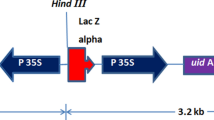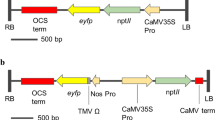Abstract
Agrobacterium-mediated transformation was used to introduce a trypsin inhibitor gene into Taiwan cauliflower (Brassica oleracea var. botrytis L.) cultivars. The TI gene was isolated from a well-adapted Taiwan sweet potato cultivar and was expected to be especially effective in combating local pests. In vitro regeneration studies indicated that 4-day-old cauliflower seedling hypocotyl segments, pretreated with 2,4-dichlorophenoxyacetic acid for 3 days and incubated on a silver-ion-containing shoot induction medium, gave regeneration rates greater than 95%. Optimum transformation conditions were determined. G418 selection at 15 mg/l was initiated 1 week after cocultivation, and the dose was doubled 1 week later. Over 100 putative transgenic plants were produced. Transgenic status was confirmed by in vitro TI activity, and Southern and Western hybridization assays. The transgenic plants demonstrated in planta resistance to local insects to which the control plants were vulnerable.
Similar content being viewed by others
Author information
Authors and Affiliations
Additional information
Received: 21 July 1997 / Revision received: 27 February 1998 / Accepted: 16 March 1998
Rights and permissions
About this article
Cite this article
Ding, LC., Hu, C., Yeh, KW. et al. Development of insect-resistant transgenic cauliflower plants expressing the trypsin inhibitor gene isolated from local sweet potato. Plant Cell Reports 17, 854–860 (1998). https://doi.org/10.1007/s002990050497
Issue Date:
DOI: https://doi.org/10.1007/s002990050497




